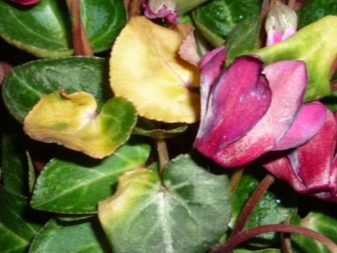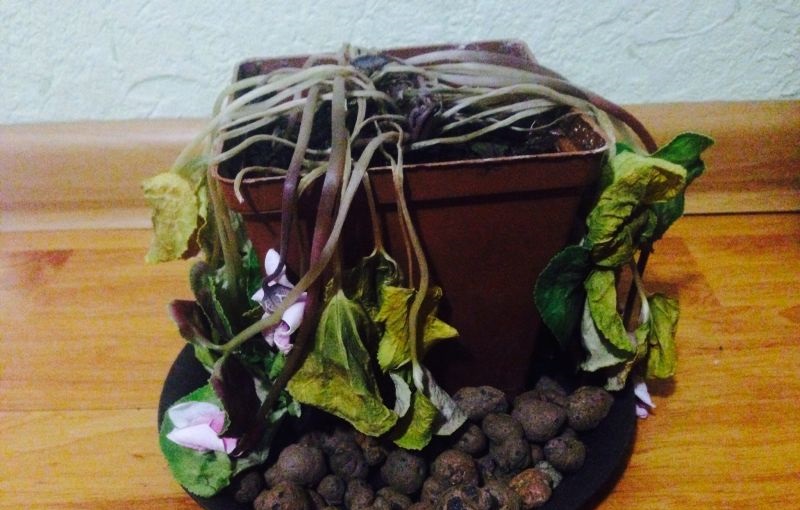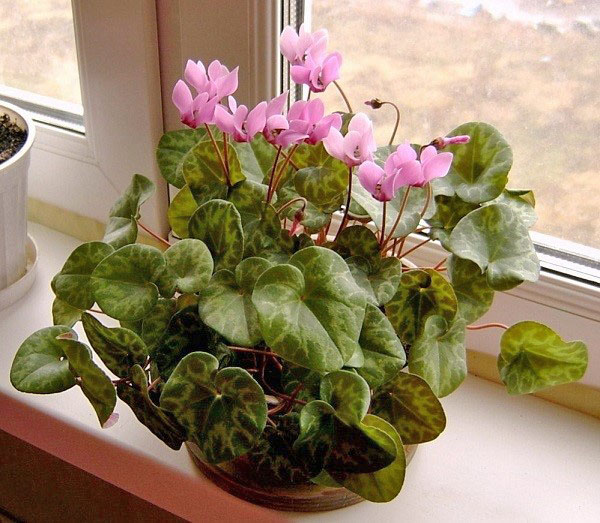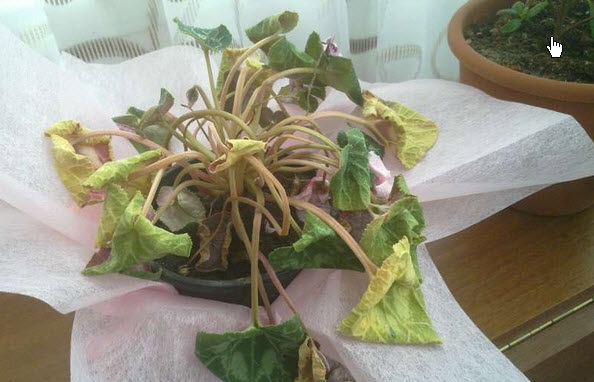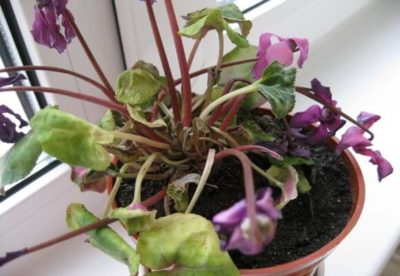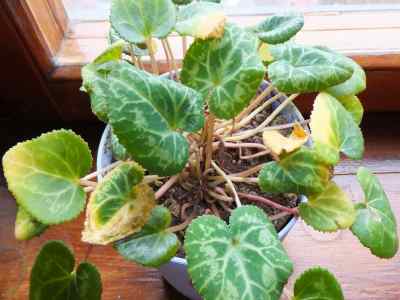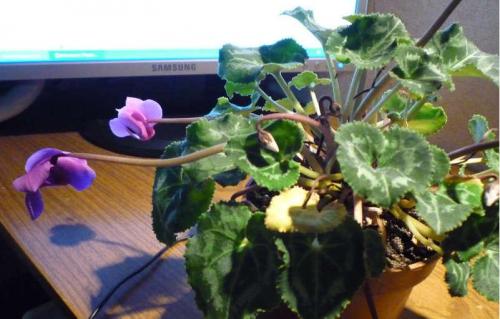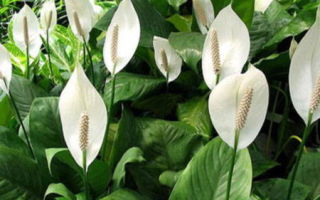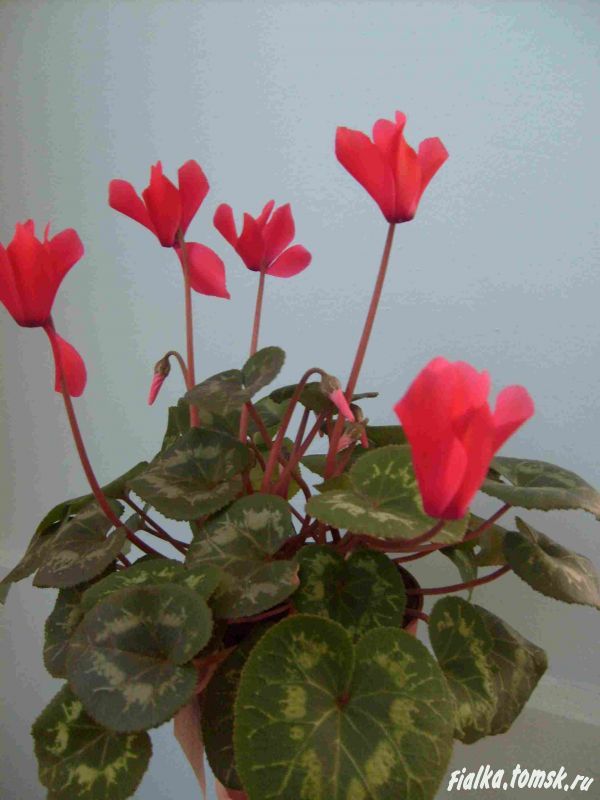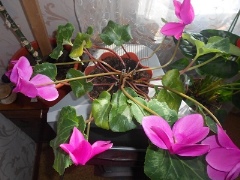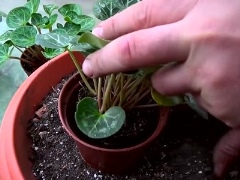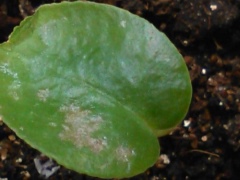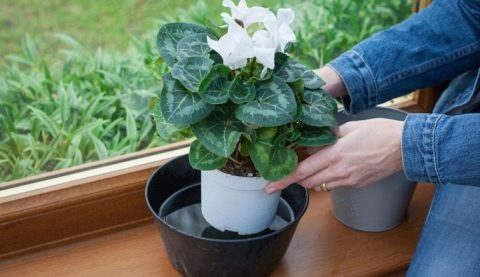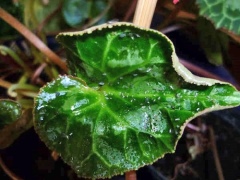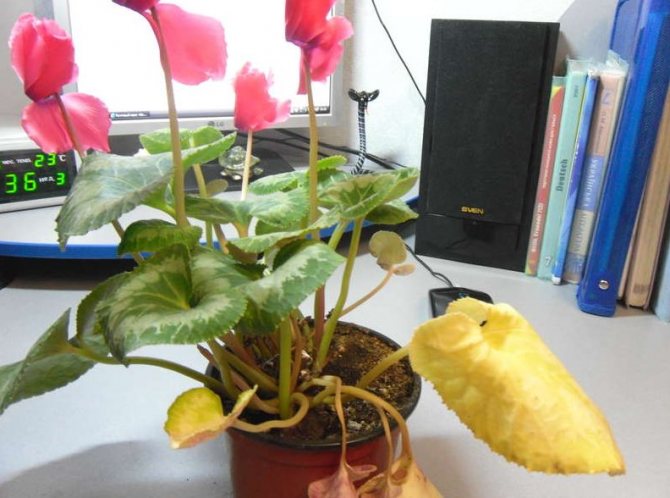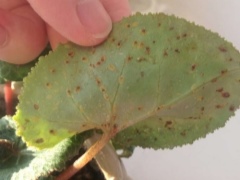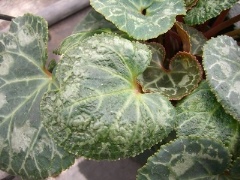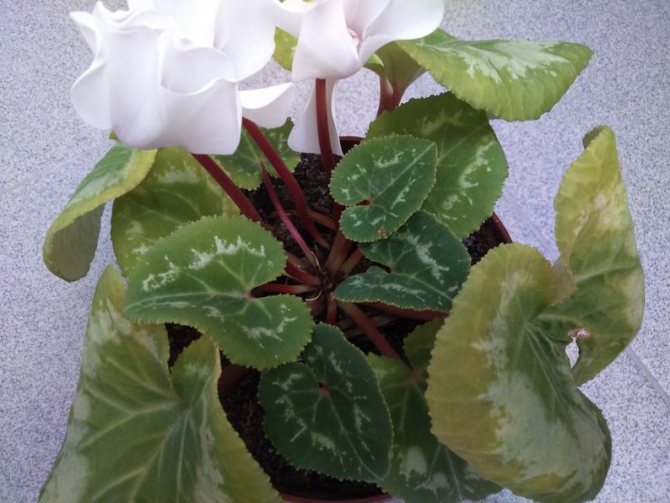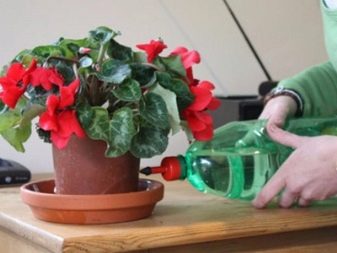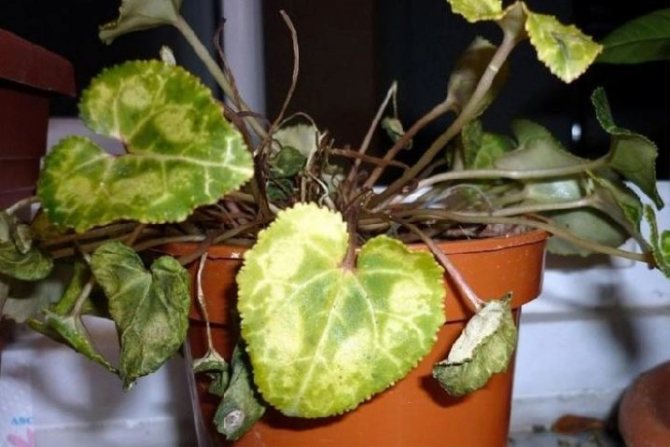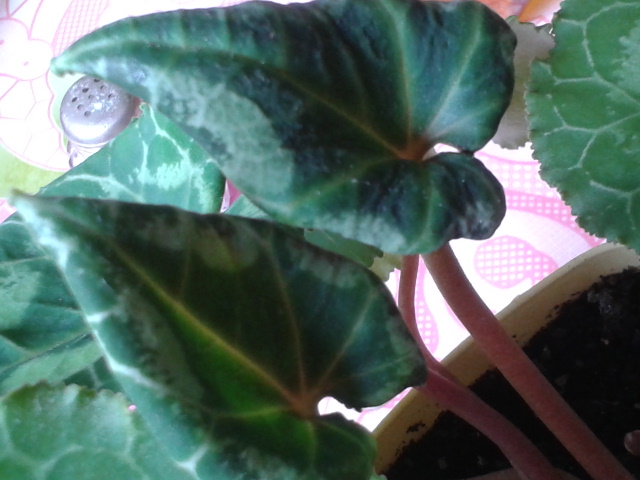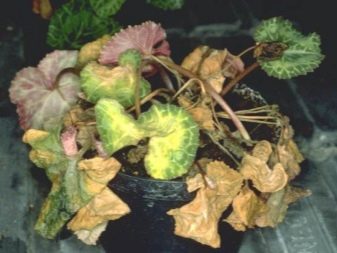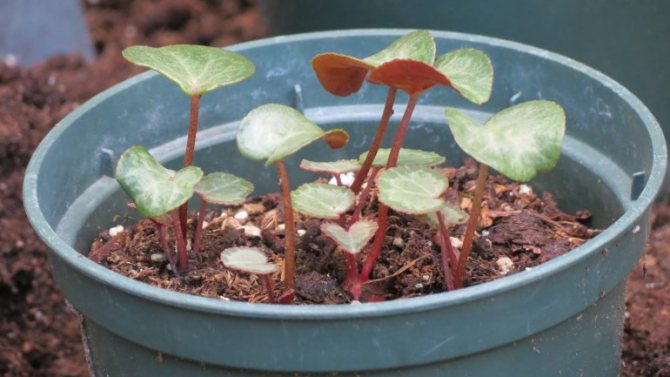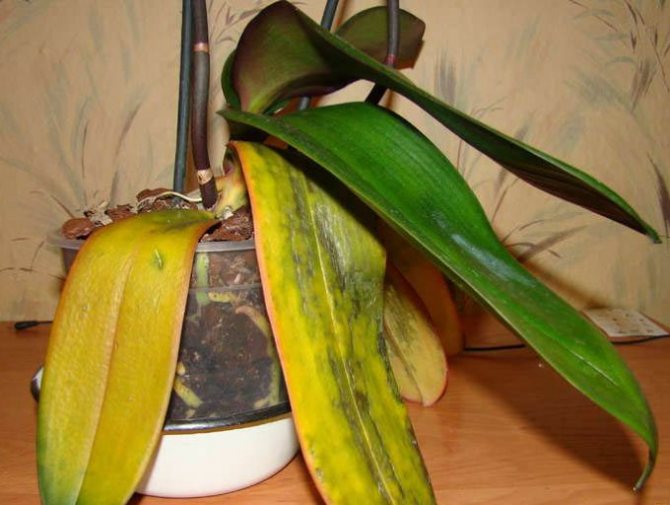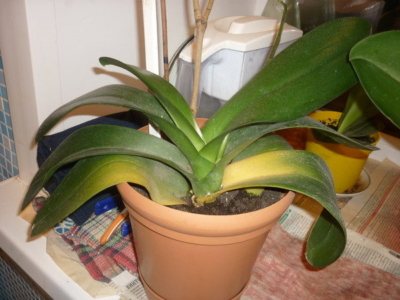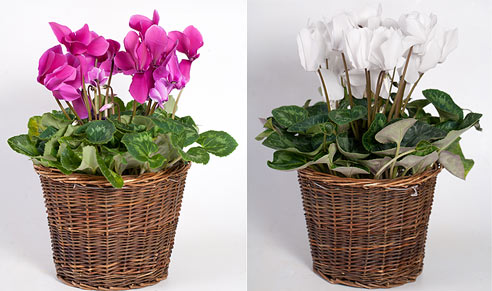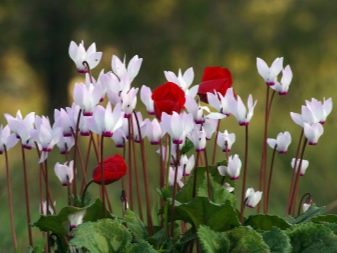How to reanimate at home?
The main program of plant resuscitation is to improve care. In most cases, it is improper watering that becomes the root cause of cyclamen disease. The flower loves moisture very much, but waterlogging is destructive for it. Water should not fall on the flower itself, you need to water it along the edge of the pots. Read here how to save a flooded cyclamen.
To keep the air around the plant moist, a tray with wet pebbles or peat is placed next to it. In the detailed instructions, we will tell you what to do if the plant disappears.
detailed instructions
The first thing to do is transplant the plant.
Carefully remove the tuber from the pot and inspect it for decay - the ability to revive the flower depends on how and how much the rot has spread. Found rotten parts, take a sharp knife and remove them to healthy tissue
So that when re-planting, these places do not rot again, they need to be processed. To do this, in 2 tbsp. l of water, dilute 1 drop of Prvikur and moisten the cut sites.
After that, we transfer the tuber to a warm, dry, well-ventilated place and leave it for 24 hours in order to stop the decay process. After a day, you need to check the cyclamen, if there are wet spots on the tuber, then we leave it for another 24 hours.
During this time, we prepare the soil - to carry out the disinfection process, for this you need to pour it into a special container and heat it well in the oven.
Some gardeners advise placing the soil in the freezer for 24 hours, but it is worth knowing that not all diseases can be ruled out in this way, for example, spores of parasitic fungi can withstand very low temperatures, while remaining viable.
If the land is bought in a store, then there is no need to process it, since it goes through the disinfection process at the time of packaging. Before planting, the pot must be rinsed and rinsed with a solution of potassium permanganate.
Plant the cyclamen, and put it in a dark place for 3 days, while watering should be very moderate.
If during this time the green leaves did not begin to turn yellow - the treatment of the tuber and the transplantation were carried out correctly, you can transfer the pot to the place familiar to the cyclamen.
Pests cause irreparable damage to the flower, and they must be properly dealt with.
You can remove any insects in the following ways:
- Insecticidal soap, which is dissolved in water at the rate of 50 grams per 4 liters of water. Soap solution is good for fighting mites and aphids. It is enough to take a cotton swab dipped in the solution and process the leaves of the plant from all sides.
- Fitoverm - this drug has proven itself well in the fight against many pests, its positive quality is the absence of an unpleasant odor and absolute safety for humans and pets. To treat a plant affected by a tick, an ampoule with a chemical is diluted with 0.5 liters of water. If thrips are started, you need to take 2 ampoules of 2 ml for the same amount of liquid. Spraying is carried out 2 times at intervals of a week.
- Argavertin is a universal preparation that destroys all insect pests. 1 ampoule is diluted with half a liter of water, the plant is sprayed. Usually one treatment is enough, but for prevention, you need to repeat the process after 2 days.
Causes and signs of defeat
Various influences can damage the flower. Experts note that the reasons leading to plant damage are most often the following:
- waterlogging of the soil in which the flower is located;
- incorrectly selected room temperature;
- irrational watering;
- decrease in humidity;
- incorrectly selected soil substrate;
- reduced insolation.
Each of these factors causes the appearance of the cyclamen to change. So, an increase in the air temperature in the room where these flowers are located leads to the fact that their beautiful buds fall off. And also such a change in the microclimate can cause the leaves to begin to dry.

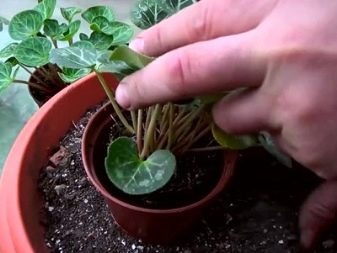
Lower temperatures can also damage the plant. You can suspect negative changes in the flower if you carefully observe it. So, if suddenly a blooming cyclamen has thrown off its buds, then in this case it is imperative to evaluate the temperature in the room where it is located. If this decorative flower is frozen, then urgent measures must be taken to help protect it from death.
Proper watering is essential for good plant growth. Some (especially beginners) flower growers are afraid to dry out the cyclamen and water it quite often.
Such frequent watering, as a rule, leads to damage to the root apparatus of an indoor flower. If the flooded cyclamen begins to rot, in this case, watering should be significantly reduced. Moreover, after overflow, the plant requires careful care.
If the cyclamen withers, then in this case it is necessary to assess the humidity. Cyclamen is a plant that withers and dies in too dry air. And also experts recommend that lovers of cyclamens think about the change in humidity in the event that the flowers have wilted.

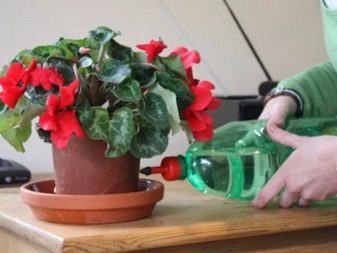
If the leaves of this decorative flower are curled, then in this case, experts recommend that you evaluate the humidity in the room. Too dry indoor air quite often leads to such specific changes. If it is not possible to change the humidity in the room with the flower in time, then with a high degree of probability its owner will have to sadly note in a few weeks that his pet has completely withered and dried up.
Various parasites can also lead to damage to the flower. Microscopic pathogenic fungi settle on the foliage of cyclamen, leading to a change in its appearance. Affected leaves in some diseases caused by parasites curl down and turn pale. And also a characteristic white bloom may appear on the foliage.
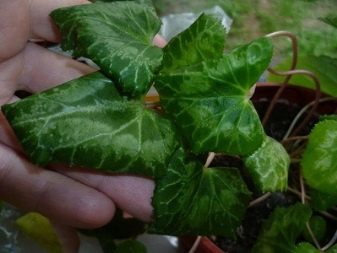

Common plant diseases
Among the ailments of the plant, the most common are yellowing, twisting and falling of leaves, fungal diseases such as fusarium, black leg, gray rot. Let's take a closer look at each ailment.
Yellowing of the leaves. Individual leaves from a bright and rich green color change to yellow. It is impossible not to notice it. Leaves can turn yellow as a result of both depletion of the soil and the insufficient volume of the pot. Solution: replenishment of the soil, or better, transplanting into another pot (we talked about when it is better to transplant basil to a garden bed or into a pot and how to do it correctly, we talked about here).
Twisting the sheet plate. The leaves are bent inward with no color change. Curling of leaves can also occur due to the characteristics of the variety. Curling leaves are especially common among large-leaved varieties. Also, twisted leaves can occur when the soil is waterlogged. To change the situation, it is necessary to reduce the frequency of watering.
Falling leaves. It is easy to notice if a scattering of dried leaves is found next to the flower. Leaves dry and fall off most often due to lack of moisture. The solution is obvious: water more often.
Fungal diseases: Black leg. It affects the stem of the plant closer to the rhizome. It is easy to notice, as the designated area darkens and subsequently becomes soft, falling off. The causative agent of blackleg is a fungus that can be found in any soil. The black leg occurs when the acidity of the soil increases and abundant watering. Remove affected plant immediately.Pour the place with a saturated raspberry solution of potassium permanganate. In advanced cases, when a group of plants is damaged, Topaz or Fitosporin can be used.
Fusarium. It affects the leaves - multiple specks appear, sometimes black. Sheets can also blacken, curl. The causative agent is the Fuzaria fungus. Gradually, the disease causes the stem to turn black, and the whole plant curls up, looks dry. Fusarium is caused by a combination of high air temperature and high humidity. At the first signs, onion peel infusion copes well with the disease. The husk is poured with boiling water in a ratio of 1 to 4 and infused for a day. The solution is sprayed on the affected plants.
Gray rot. It appears from the fungus Botrytis cinerea and affects the lower leaves first, spreading throughout the plant
It begins with the appearance of grayish spots on the leaves, and ends with the formation of a thick gray cannon, which is difficult to miss. Gray rot often appears in greenhouses and greenhouses due to the presence of condensation, plant residues, and moisture residues in which the pathogen fungus lives.
Important. It is necessary to fight gray rot first of all prophylactically: do not plant basil in the same place, process the seeds before planting in a slightly pink potassium permanganate, avoid crowding in the plantings, water moderately.
How to choose the right Persian cyclamen
Even properly planted plants will never delight you with their flowering if the wrong care is taken. And full-fledged competent care begins with watering. It should be regular and moderate at the same time.
Watering is from above, trying not to fall on leaves, flowers and tuber
Pay attention to the water for irrigation. To do this, it is worthwhile to defend the water bottle in advance until it reaches room temperature.
If it is possible to pass water through a filter, do so. The liquid should be soft.
Do not water if the soil is not dry yet. If water accumulates in the pan, dispose of it immediately. Despite the fact that Cyclamen loves abundant watering, excessive moisture or even a bay should not be allowed. But do not leave the plant dry for a long time, because this entails vulnerability to tick damage.
Top dressing is a prerequisite for those plants that delight you with their flowering. During the flowering period, you need to fertilize once a week, using half doses. After you have purchased the plant, it is worth feeding after a month.
You should not resort to such a procedure right away, because there is a possibility that the flower is not used to a new place and will experience a double shock. Purchase a fertilizer with no or minimal nitrogen content.
Special attention should be paid to the issue of caring for Persian cyclamen after its flowering. The plant goes into a dormant state, which means excess moisture can lead to its decay
Therefore, as soon as the flowers disappear on the plant, it is necessary to reduce the amount and frequency of watering.
As for the transplant of such a plant, it is recommended to do such a procedure every 4 years.
Cyclamen reacts poorly to a change in its habitat, it can get sick or wither away, so try to immediately transplant this plant into a pot with a margin.
As for the tick, the leaves and stems turn bright yellow, then begin to dry and serve.
If you decide to buy an already planted cyclamen, then give preference to flowering plants. Such a flower has already blossomed several buds, and the rest have remained unopened, thanks to which the flowering will be long. The leaves should be without yellowness, and the peduncles themselves should be straight
Pay attention to the center of the flower so that there is no gray bloom in it, the presence of which indicates that the plant is affected by gray rot
In Persian cyclamen, the tuber must protrude slightly above ground level.Most often, cyclamen is sold in the fall, so make sure that the flower is well wrapped when you buy it.
How to care?
In order for a plant to bloom and please the eye, you need to know how to properly care for it. First of all, the flower must be protected from drafts. If you decide to put it on the windowsill, then it is advisable that the window does not open there. But surprisingly, it grows remarkably in a cool room, where it is only 10-12 degrees.
Cyclamen needs light, but direct sunlight is harmful to him.
Pests
Do not forget that flowers also have pests. Cyclamen is not often attacked by pests and parasites, but a cyclamen mite can infect a plant. Crooked peduncles, curved buds, twisted leaves will become a sign of defeat. In order to prevent the appearance of this pest, for prevention, the plant should be sprayed with a special pest preparation once a month.
Watering
You need to water the plant in a tray, you cannot water the plant from above, otherwise the tubers may begin to rot. It is necessary to distribute moisture evenly so that overflow does not happen or, conversely, does not dry out the earthen lump.
Cyclamen should be fed constantly, except for the rest period. Top dressing should be started a couple of weeks after purchasing the plant. If you have grown cyclamen on your own, you should start feeding a week after the sprouts appear.
Before feeding, you should make sure that the earthen lump is well saturated with water. Complex mineral fertilizers are well suited for feeding.
Transfer
The correct transplantation also affects flowering. It is necessary to transplant cyclamen very carefully so as not to damage the roots. The plant needs to be transplanted into a low but wide container.
TIP: Until the roots have completely taken root, do not water very often, and then gradually increase the moisture.
It is very important to create aeration of the cyclamen root system. It is advisable to use a breathable coarse peat substrate
For an optimal soil composition, equal parts of sand, humus and peat are needed, as well as three parts of leafy soil. In order not to risk it, the soil for cyclamen can be purchased at a special flower shop.
The transplant should be done in the summer, while the plant is not blooming. For the transplant to proceed correctly, follow these rules:
- before planting on the bottom of the pot, you must first pour a layer of expanded clay, then add the prepared soil, on which to place the plant and sprinkle it on the sides with an earthen mixture;
- after transplanting, the upper third of the plant tuber should remain above the ground;
- after transplanting, the plant should be watered after 10-12 days;
- after the transplant has been made, in early September, when young leaves begin to form, the flower must be rearranged in a cool but sunny place.
Watch a video about the correct Cyclomen transplant:
Cyclamen turns yellow: what to do?

Cyclamen is an amazing, beautiful houseplant. This explains its popularity among flower growers. In addition, delicate inflorescences bloom in late autumn and delight with their flowering until spring.
Achieving such a long flowering is not easy at all. Cyclamen requires an attentive attitude towards itself.
Often, flower growers, especially beginners, are faced with the following problem: cyclamens turn yellow, damaged leaves fall off, flowers wither.
In order to understand the reason for this phenomenon, it is necessary to understand the biological characteristics of this unusual plant. Cyclamen is a tuberous perennial flower. Its height, depending on the variety, can reach 35 cm.
Juicy leaves, which have an original color, are located on dark red petioles. The tuber of a plant is a bulb with only one growth point. This structure of cyclamen makes it very "vulnerable".
At the slightest damage to the bulb, the flower experiences stress, signs of illness, wilting appear. For this reason, the leaves of cyclamen turn yellow and fall off. In case of severe damage to the tuber, the complete death of the plant is possible.
How to proceed?
So, how can you save a flooded cyclamen and what to do if you overwet the plant too much? The success of measures to save cyclamen is determined by the degree of rotting of the tuber.
- If there is a little rotted part, there is a chance of recovery. An urgent transplant is required:
- Prepare a pot with a hole in the bottom, as well as drainage and soil. The soil can be purchased at a specialized store or prepared by yourself. A breathable coarse peat substrate is required. For a soil mixture, leafy earth, humus, peat and sand should be combined in equal proportions.
On a note. If there is no new soil, you can use the old one. First, make sure that it does not smell like rot or mold, and dry it. - Disinfect soil and pot if not new. Bake the substrate in an oven preheated to 80 degrees for 30 minutes.
- Remove the flooded plant from the pot.
- Carefully loosen soil residues from the roots.
- Examine them.
- If the roots are firm and elastic, the overflow of the plant has not yet led to irreversible consequences.
- Place the plant on pre-spread newspapers.
- Blot the root system, let it dry.
- Pour a drainage layer 5 centimeters into the bottom of the pot. You can use expanded clay, clay shards, tiny foam plastic, coal, vermiculite.
- Place fresh, slightly moistened soil on the drain so that after transplanting one third of the tuber is above the surface.
- To stimulate, slightly dust the root system with root.
- Plant the plant in the center of the pot and add a little substrate. In the summertime, place expanded clay on the surface of the soil to prevent overheating.
- Prepare a pot with a hole in the bottom, as well as drainage and soil. The soil can be purchased at a specialized store or prepared by yourself. A breathable coarse peat substrate is required. For a soil mixture, leafy earth, humus, peat and sand should be combined in equal proportions.
-
If some of the roots have become soft, brown, the process of root decay has already begun. To save the cyclamen you need:
- Flush the root system.
- Trim rotten roots with scissors or a sharp knife to healthy, dense tissue.
- Dry the root system.
- Sprinkle the cut with crushed activated carbon.
- Plant the plant in fresh or dried soil.
- Then proceed as described above.
- If all the roots are soft, brown, it will not be possible to save the plant. You can cut the cuttings, treat them with root roots and try to root them in a greenhouse, for example, under a plastic bottle.
-
If the tuber is rotten:
- The decayed part should be cut out to a healthy place.
- Dry slightly, treat with activated carbon powder.
- Plant in fresh cyclamen soil. The tuber should be half above ground level and the roots should not curl upward.
Note! Do not place a flooded plant in the sun - its roots will mate.
You can learn more about how to reanimate cyclamen at home here.
Why does cyclamen shed leaves, how to save a plant from death?
Cyclamen can shed leaves for several reasons. You can understand whether this is a reason for excitement if you carefully observe the flower. If it begins to turn yellow and wither slowly, and then just as slowly gets rid of old leaves, then it's time for a seasonal rest. In this case, there are no health problems.
Cyclamen leaves turn yellow
If the branches become bare in a matter of days, then the plant is sick. Why is this happening? Improper care or parasite infestation may be the cause. In any case, you should not despair: timely treatment will give a positive result.
Imperfect care during and after flowering
Northeast Africa is considered the homeland of cyclamens. The sunny, humid climate of this part of the world allows the flower to grow to incredible sizes and bloom profusely at the same time. However, it is incredibly difficult to recreate ideal conditions in an ordinary apartment.If this is not possible, the plant turns yellow and sheds its leaves. In this case, you need to analyze what exactly could upset the plant. This could be:
too high or low air temperature. Cyclamen prefers to grow and bloom at home at 12-17 degrees above zero. In winter, it feels great on glazed balconies, but during severe frosts it is better to bring it into the house.
improper watering. Most cyclamen varieties have a moderate appetite. They should be watered about once a week, when the substrate is almost completely dry. It is necessary to ensure that the entire earthen lump is moistened without turning into a swamp. Drought is also fatal to the flower. The soil in the cyclamen pot should not be allowed to remain dry for several days;
Water the cyclamen once a week.
- direct sunlight. Cyclamen loves diffused light. Rays falling directly on the delicate leaves of the flower can cause burns. The result is yellowing and dropping;
- lack of nutrients. Special fertilizers need to be applied regularly: after transplanting into a new pot, once every two weeks, after the appearance of buds, once a month.
Natural process
Cyclamen is a cyclic plant. After flowering, which can last for several months, it retires. At this time, his leaves also begin to turn yellow and dry. They must be removed by unscrewing them at the base.
A dormant flower is either left in a pot or a tuber is dug up. In the first case, the plant is rearranged in a shaded cool place and watering is severely limited.
Cyclamen tuber after flowering
In the second, the onions are cleaned and stored in a dry, ventilated place at a temperature of 10-25 degrees above zero. They are planted in a new substrate in late summer - early autumn.
Cyclamen can also get sick and shed the leaves due to changes in his life: after transplanting or moving to another place. If the new conditions meet the needs of the plant, then all that is required of the owner is to remove the yellowed leaves and wait for the flower to come to its senses. Of course, without ceasing to carefully look after him.
Plant pests
Yellowed cyclamen leaves may indicate that pests have appeared in the flower pot. How to recognize who exactly interferes with the plant's life when it starts to disappear and what to do to revive it, you can from the table.
| Fungi | Fusarium | The plant turns yellow and dries up gradually, the process starts from the tops of the leaves. | The flower is taken out of the pot, cleaned, removes the affected areas of the tuber, treated with fungicide and planted in freshly calcined soil. |
|---|---|---|---|
| Gray rot or Botrytis | First, a gray bloom appears on the leaves, and only then they begin to turn yellow quickly. | The affected areas are removed with a sharp blade and the whole plant is treated with a fungicide. | |
| Erwinia | The leaves turn yellow and die off very quickly. | The affected areas are removed with a sharp blade and the whole plant is treated with a fungicide. | |
| Mites | Red tick | A cobweb forms on the underside of the leaves, then the plant turns yellow. | The affected leaves are removed, the cyclamen is treated with an insecticide. |
| Cyclamen mite | The process of damage begins with deformation of the leaves. Having changed their shape, they turn yellow and fall off. | All means are powerless, it remains only to destroy the plant. | |
| Viruses | Bronze of leaves | The leaves are deformed at first, then turn yellow and dry out. | No cure is possible. The flower must be destroyed to prevent contamination of other plants. |
| Ring mosaic | Round light spots form on the leaves, which then crack and turn into holes. |

